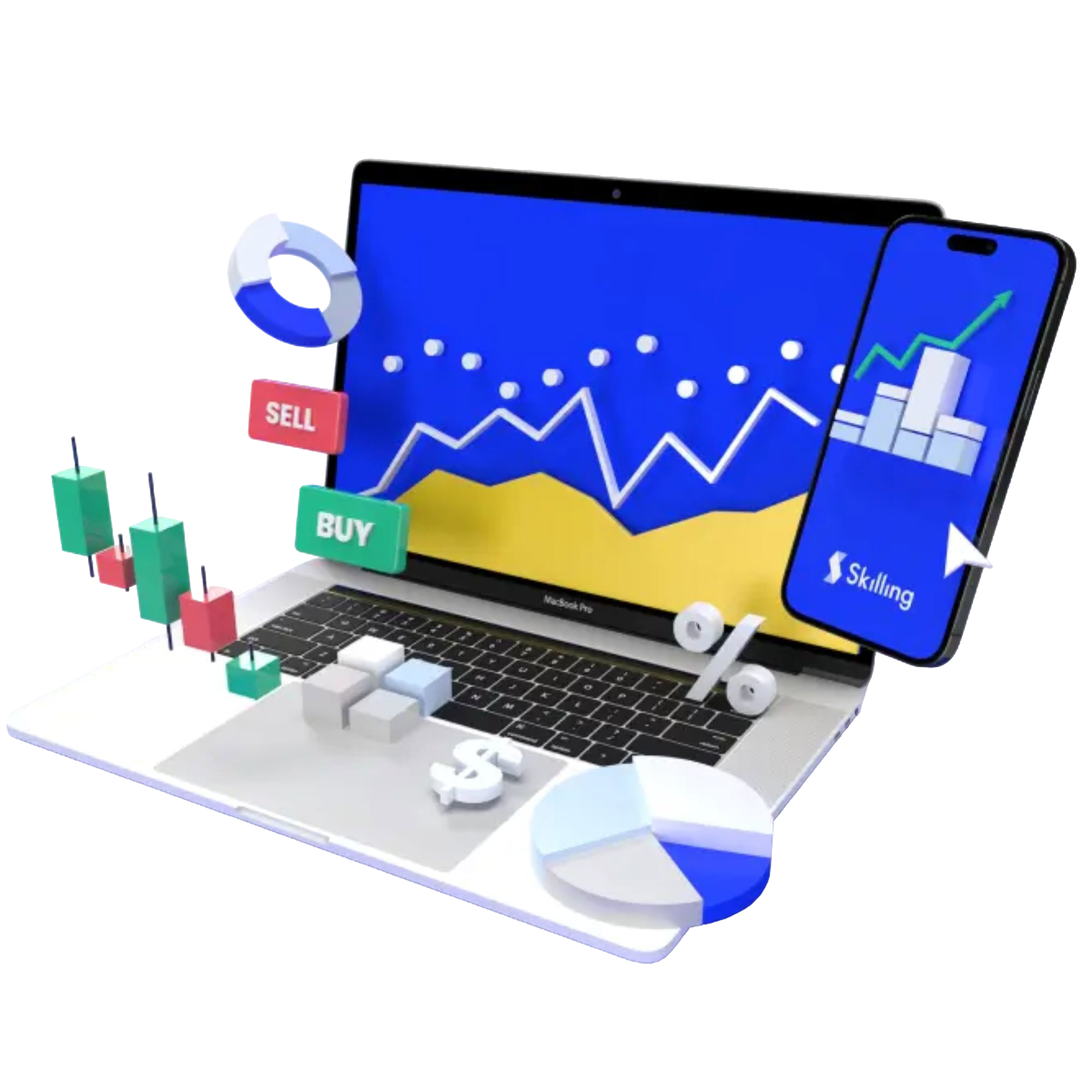Interest rates make the world go around. They're like the heartbeat of the economy, influencing everything from buying a home, to borrowing money for a new business venture, to trading financial instruments like stocks, Forex, cryptocurrencies, etc. But what exactly are interest rates, what role do they play and how do we calculate them?
What is interest rate?
Think of interest rates as the cost of borrowing money or the reward for saving it. When you borrow money, like taking out a loan or using a credit card, you usually have to pay back more than you borrowed. That "more" is the interest. On the flip side, when you save money in a bank account, the bank pays you interest as a thank-you for letting them use your money.
If interest rates rise, traditional investments like bonds tend to become more appealing, potentially reducing demand for instruments like Bitcoin. Conversely, lower interest rates might make instruments like Bitcoin price, stocks etc. relatively more attractive, increasing demand and potentially driving up the price.
Types of interest rates
Now, let's break down types of interest and how they are calculated. There are two main types: simple interest and compound interest.
- Simple interest: Simple interest is like the straightforward, easy-to-follow cousin. It's calculated based only on the initial amount of money you borrowed or saved, called the principal, and the rate of interest. So, if you borrowed $100 with a simple interest rate of 5% per year, you'd owe $5 in interest every year. Simple, right?
- Compound interest: Compound interest, on the other hand, is a bit more complex but can be super powerful. It's like interest on steroids because it not only considers the initial amount and the interest rate but also adds in any interest already earned or paid. This means you earn interest on your interest, creating a snowball effect that can grow your money faster over time.
Now let's break down how they are calculated and their formulas:
Simple Interest:
Simple Interest (I) = Principal (P) × Rate (R) × Time (T)
Example:
Let's say you borrow $100 with a simple interest rate of 5% per year for 3 years.
Principal (P) = $100
Rate (R) = 5% = 0.05
Time (T) = 3 years
Plug these values into the formula:
I = $100 × 0.05 × 3 = $15
So, you would owe $15 in interest over the 3 years.
Compound Interest:
Compound Interest (A) = P × (1 + r/n)^(nt) - P
Where:
A is the future value of the investment/loan, including interest.
P is the principal amount (initial investment/loan amount).
r is the annual interest rate (in decimal).
n is the number of times interest is compounded per time period.
It is the time the money is invested or borrowed for, in years.
Example:
Let's say you invest $1000 at an annual interest rate of 5%, compounded annually for 3 years.
Principal (P) = $1000
Rate (r) = 5% = 0.05
Time (t) = 3 years
Number of times compounded per year (n) = 1 (compounded annually)
Plug these values into the formula:
A = $1000 × (1 + 0.05/1)^(1×3) - $1000
Calculating:
A = $1000 × (1 + 0.05)^3 - $1000
A = $1000 × (1.05)^3 - $1000
A = $1000 × (1.157625) - $1000
A ≈ $1157.63 - $1000
A ≈ $157.63
So, the future value of your investment after 3 years, including compound interest, would be approximately $1157.63.
Practice with a Demo Account
Try our demo account and experience real market conditions.
71% of retail CFD accounts lose money.

What role does interest rate play?
Interest rates play a crucial role in the world of money. They're like the traffic lights of the financial system, guiding how money flows between people, businesses, and governments. Here's how interest rates shape our financial landscape in simple terms:
- Cost of borrowing: When you borrow money, like taking out a loan for a car or a mortgage for a house, you typically have to pay back more than you borrowed. That "extra" amount is the interest. So, interest rates determine how much it will cost you to borrow money. Higher interest rates mean higher borrowing costs, while lower rates mean lower costs.
- Reward for saving: On the flip side, if you save money in a bank account or invest in bonds or other financial products, you earn interest on your savings. Interest rates determine how much you earn on your savings. Higher interest rates mean higher returns on your savings, while lower rates mean lower returns.
- Influencing spending and investing: Interest rates also influence people's decisions about spending and investing. When interest rates are low, borrowing becomes cheaper, so people and businesses are more likely to borrow money to buy homes, cars, or invest in new projects. This could stimulate economic growth. On the other hand, when interest rates are high, borrowing becomes more expensive, so people and businesses may cut back on spending and investing, which can slow down the economy.
- Controlling inflation: Central banks, like the Federal Reserve in the U.S. or the European Central Bank in Europe, use interest rates as a tool to control inflation. When inflation is rising too fast, central banks may raise interest rates to cool down spending and borrowing, which can help to lower inflation. Conversely, when inflation is too low, central banks may lower interest rates to encourage more spending and borrowing, which could help to boost inflation.
Capitalise on volatility in cryptocurrency markets
Take a position on moving cryptocurrency prices. Never miss an opportunity.
71% of retail CFD accounts lose money.

What causes interest rates to fall or rise?
- Supply and demand for money: Just like any other product, the price of money (interest rates) is influenced by supply and demand. When lots of people want to borrow money (high demand) and there isn't much money available to lend (low supply), lenders can charge higher interest rates. Conversely, when there's plenty of money to lend and not many people want to borrow (low demand), interest rates tend to fall. Example: Imagine during a booming economy, many businesses want to borrow money to expand, but there aren't enough lenders willing to lend. In this case, interest rates might rise to attract more lenders.
- Central Bank policies: Central banks, like the Federal Reserve in the U.S., have a big say in interest rates. They use tools like adjusting the "benchmark" interest rate (the rate at which banks borrow from each other) to influence the overall level of interest rates in the economy. When they want to encourage borrowing and spending, they may lower interest rates. And when they want to cool down an overheating economy or control inflation, they may raise interest rates. Example: If the central bank sees inflation rising too quickly, they might raise interest rates to make borrowing more expensive, which can help slow down spending and cool off inflation.
- Inflation expectations: If people expect prices to go up in the future (inflation), lenders might demand higher interest rates to compensate for the decrease in purchasing power of the money they'll get paid back in the future. So, expectations about future inflation could influence current interest rates. Example: If people expect prices for goods and services to rise next year, they may expect higher interest rates to compensate, which could lead to higher interest rates today.
- Global economic conditions: Interest rates could also be influenced by what's happening in other countries. If interest rates are higher in one country compared to another, investors might move their money to the country with higher rates, pushing down rates there and raising them in the other country. Example: If interest rates in the U.S. are higher than in Europe, investors might move their money from European bonds to U.S. bonds, causing U.S. interest rates to fall and European interest rates to rise.
Disclaimer: Past performance is not indicative of future results. Market conditions, central bank policies, inflation expectations, and global economic conditions are complex factors that could impact financial markets and the performance of various financial instruments.
FAQs
1. What are interest rates?
Interest rates are the cost of borrowing money or the reward for saving it. When you borrow money, you typically pay interest on top of the amount borrowed. When you save money, you earn interest on your savings. These rates are expressed as a percentage of the loan or deposit amount.
2. How do interest rates affect the economy?
Interest rates influence spending, borrowing, and investing decisions. When rates are low, borrowing becomes cheaper, stimulating spending and investment. Conversely, high rates can discourage borrowing, slowing down economic activity. Central banks use interest rates as a tool to control inflation and stabilise the economy.
3. How are interest rates determined?
Interest rates are determined by factors such as supply and demand for money, central bank policies, inflation expectations, and global economic conditions. For example, if demand for loans is high but money supply is low, rates tend to rise. Conversely, if central banks lower rates to boost the economy, rates may fall.











